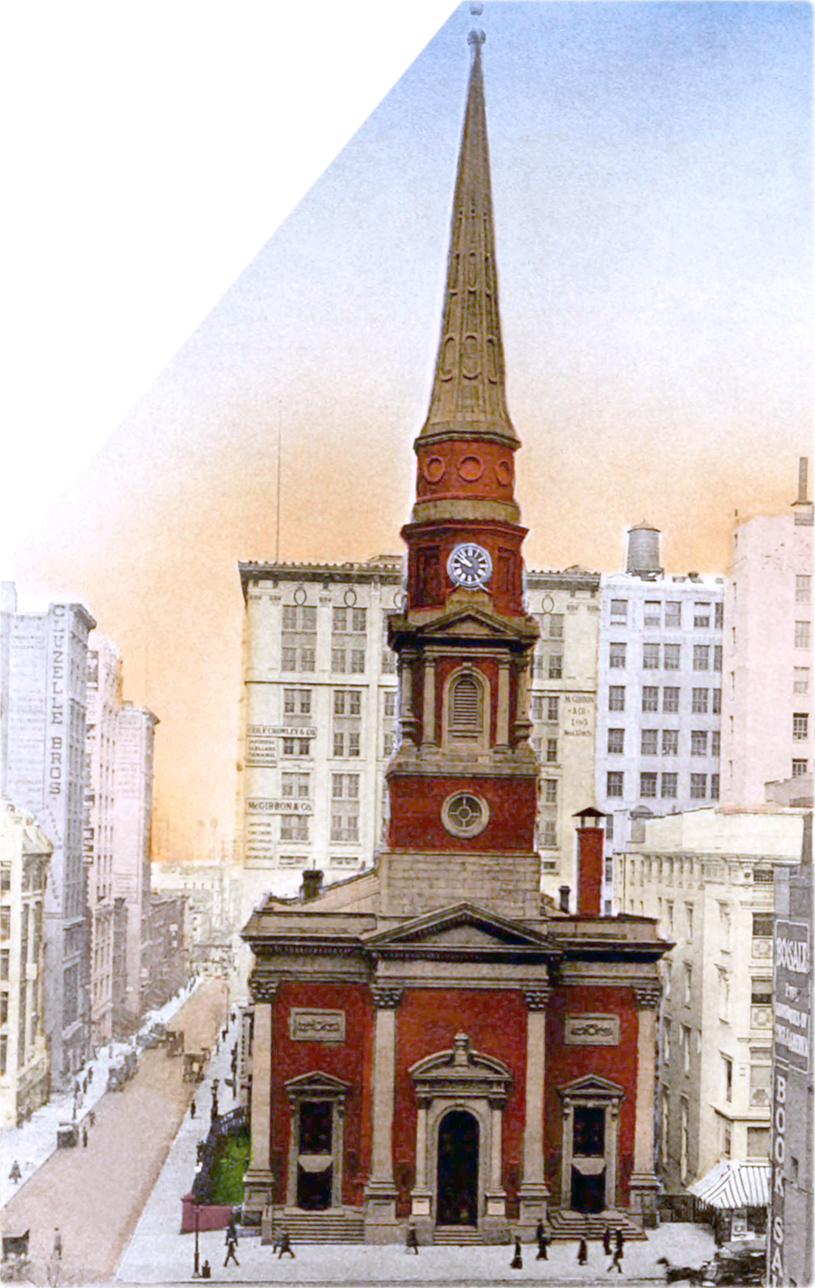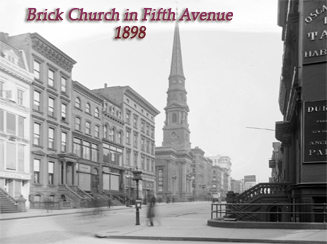
Brick Church on Fifth Avenue
The Brick Presbyterian Church was originally an expansion of the First Presbyterian Church at Wall Street. In the late 18th century it was called "New Presbyterian Meeting" on Beekman Street. In 1809, it became a separate and incorporated entity as The Brick Presbyterian Church in the City of New York.

In 1940, the present Brick Church temple was erected on
Park Avenue at 91st Street. Below,
some text from A Short History of the Brick Presbyterian Church in the City
of New York, 1943, by James McCullough Farr.
«Midway in Dr. [Gardiner] Spring's pastorate [about the 1840s] the question began to be agitated as to whether the Church ought not to follow the movement of population into the upper part of the city. The Beekman Street lot which, when the Church was built on it, was at the very edge of the residential district was now a long way down town. It was in the neighborhood of Union Square that its people were now living. Only the most devoted of the old members continued to attend faithfully. New members were difficult to recruit. If the Church was to serve the people it should be located in the midst of the people. So the argument ran. Expediency militated against sentiment. Finally expedience won the debate. In 1856 the congregation secured the right to dispose of its old leasehold. The property was sold for $200,000. The lot, "way up town" at the corner of 37th Street and Fifth Avenue was bought for $58,000; a new "brick" church was erected on it and consecrated on October 31st, 1858. Dr. Spring, now seventy-three years old, but still preserving a large portion of his youthful vigor, conducted the service. A crowded congregation was in attendance. "Fifth Avenue was completely blocked with carriages for a long time after the close of the services."
Now began a new and notable era in the history of the Brick Church, an era which was to last for eighty years and with the latter part of which many members of the congregation, still living, were identified. It began slowly enough. Dr. Spring, in spite of his vigor, was an old man and the conservative traditions of a life-time would continue to dominate the activities of the Church for the remaining fifteen years of his pastorate. Younger men were called to be his associates. James Hoge, a young, handsome, earnest man, came in 1859 and made a great impression by his eloquent sermons. But he was a southerner, and when the Civil War broke out his situation became impossible and he resigned. Then came William G. T. Shedd, a brilliant theologian and teacher. He was out of his niche; also his health was not good, so in a year's time he accepted a call to the Union Theological Seminary where he had a distinguished career. James Ormsby Murray was called in 1865 and remained for ten years. He became professor of literature at Princeton College. The writer attended his classes there. Dr. Murray was the perfect example of the "gentleman and scholar." He was greatly respected by the students but he was too quiet and restrained to arouse the Church from the somewhat somnolent respectability into which it had settled during the latter years of Dr. Spring's long pastorate.
 To supply the need of which it was conscious of a leader full of evangelistic
fervour, in 1875, Dr. Murray having resigned and Dr. Spring having died, the
Church followed a fashion of the day and for the one and only time sought a
minister from abroad and called from London a Welshman named Llewelyn Bevin. Dr.
Bevin had a great reputation as an eloquent and inspiring preacher. A great
congregation attended his first sermon. Then Dr. Bevin made a most unfortunate
"break," which the writer as a child heard discussed in his family circle, and
which the new preacher never wholly lived down. It seems there was a woman in
the congregation who annoyed him by her coughing. Dr. Bevin fixed his eye upon
her several times, but when the coughing continued he finally requested her
to leave the church. It was too bad, but it was one of those things which
everyone spoke about and nobody forgot. He stayed on as pastor for five years
and then returned to London, and later went to Australia where he had a notably
successful ministry.
To supply the need of which it was conscious of a leader full of evangelistic
fervour, in 1875, Dr. Murray having resigned and Dr. Spring having died, the
Church followed a fashion of the day and for the one and only time sought a
minister from abroad and called from London a Welshman named Llewelyn Bevin. Dr.
Bevin had a great reputation as an eloquent and inspiring preacher. A great
congregation attended his first sermon. Then Dr. Bevin made a most unfortunate
"break," which the writer as a child heard discussed in his family circle, and
which the new preacher never wholly lived down. It seems there was a woman in
the congregation who annoyed him by her coughing. Dr. Bevin fixed his eye upon
her several times, but when the coughing continued he finally requested her
to leave the church. It was too bad, but it was one of those things which
everyone spoke about and nobody forgot. He stayed on as pastor for five years
and then returned to London, and later went to Australia where he had a notably
successful ministry.
THE MODERN ERA
A new era in the history of the Brick Church began with the coming of Henry van Dyke in 1883. He was barely thirty years old but had already manifested his unusual qualities in a successful pastorate at Newport. He had exceptional literary gifts and was a poet of no mean order. He was ardent and eloquent and dead in earnest. He saw a great future for the old church on Murray Hill with its fine background of traditions and a devoted if small church membership. He was a bold leader, and the first outward and visible sign of the new order was the transformation of the church's interior, under the direction of John La Farge, from a conventional and austere meeting house into a basilica glowing with color and rich with ornamentation. Here was an unmistakable evidence that "old things had passed away," that a new spirit was animating the venerable body. It was in truth a new birth. Those were the days of the great "Briggs controversy." The whole Presbyterian Church was profoundly shaken by the conflict between the old and the new, but, whereas many ministers hesitated and hedged, Henry van Dyke came out boldly as a leader of liberal thought. ...»
The Brick Church at 37th Street and Fifth Avenue. A hand color photo published in A Short History of the Brick Presbyterian Church in the City of New York, 1943, by James McCullough Farr.
|
Copyright © Geographic Guide - Old NYC. Historic Buildings. |
The congregation moved in 1858 to the second temple on Murray Hill, Fifth Avenue and 37th Street. The temple was dedicated on 31st October. The spire was 250 feet high and the old bell was on it.
In 1937, Brick Church merged with Park Avenue Presbyterian Church located at Park Avenue and 85th Street. In 1938, the second temple of Brick Church on Fifth Avenue was demolished. A new building was erected on the site, demolished in 1984. Now, there is a 30-story skyscraper on the site.
Continue below...
1858 − 1937
Brick Church on Fifth Avenue
